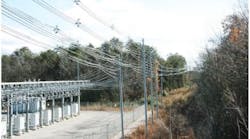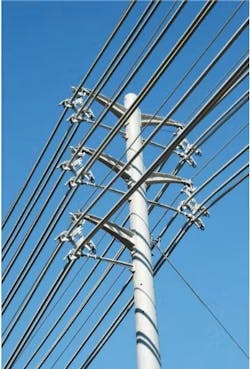Fort Loudoun Electric Cooperative (FLEC) faced serious challenges keeping up with the area's growth. While the recent economic downturn has slowed development somewhat, the area has grown at a record pace for the past 20 years. This primarily was due to the explosive expansion of residential, commercial and educational facilities in Blount County, the second-fastest growing area in Tennessee.
The challenging mountainous geography and limited rights-of-way drove FLEC to look for alternatives to traditional open-wire structures, especially at substation exits. One possible solution was the use of a spacer cable system, which features a compact configuration as well as reduced clearance requirements.
Increasing Flexibility
FLEC had used spacer cable in the 1970s to under-build a congested area of the small town of Friendsville, Tennessee. This allowed engineers to add a new line by weaving through the area without having to reconstruct the existing open wire structure. The spacer cable system was supplied by Hendrix, a New Hampshire-based Marmon Berkshire Hathaway firm that provides underground cable, spacer cable, tree wire, insulators and other overhead accessory products worldwide.
In the early 1990s, FLEC used the spacer cable system to solve tight space constraints and recently began to consider other uses for spacer cable that would add more capacity. Spacer cable is the best solution for FLEC for three main reasons:
Limited right-of-way is the driving factor; there is simply no way to obtain the additional right-of-way needed for open wire circuits.
Spacer cable gives FLEC the ability to be flexible with the number of circuits in the right-of-way corridor and the configuration and clearance requirements
The spacer cable solution allows the use of the existing pole line.
The coop does not want to have to change poles, and the spacer cable makes it relatively easy for linemen to add an additional circuit on an existing line using spacer cable. Under-building using the same poles results in significant savings.
FLEC offers its customers the option of spacer cable whenever feasible, in a rocky area, for a tap line or when there is a lot of vegetation. Many customers have chosen single-phase spacer cable when there is just enough right-of-way to get the line through. Also, since much of the service area is located in the foothills of the Smoky Mountains, FLEC tends to leave hardwood trees close to the circuit, so any softwood trees that fall tend to be caught by the hardwood instead of falling on the line. FLEC still maintains clearances but not as much as are needed with open wire structures.
Allowing Multiple Circuits on a Single Pole
Spacer cable systems feature a compact configuration and reduced clearance requirements, which means multiple circuits can be installed on a single pole. Over- or under-building spacer cable systems in substation exits can reduce the cost of adding capacity.
A spacer cable system consists of a messenger cable that supports the structure, polyethylene spacers to hold the cable across spans and covered conductor cable. The messenger cable is the support member for the structure and serves as both system neutral and lightning shield. Their mechanical strength makes them suitable for long spans.
Clipped to the top of the messenger wire is a series of spacers, molded using a proprietary, gray, track-resistant, high- density polyethylene. The spacers support, separate and clamp the phase conductors in a triangular, diamond-like configuration.
Spacers are placed between spans of about 30 ft to 40 ft. They feature quick, easy installation and removal. No ring ties are required; patented integral clamps are used for conductors and messenger. The clamp design accommodates a full range of conductor and messenger sizes. The wedge-shaped messenger hook provides maximum grip.
The spacers have weather-washing characteristics, and their design provides high short-circuit strength. They are highly resistant to shock, impact or rifle fire, and can be installed with hot line tools.
Covered conductors consist of stranded hard drawn aluminum conductors with three extruded layers, the thickness of which depends on the voltage rating. Hendrix's proprietary, high-density outer layer resists abrasion, electrical tracking and UV degradation. Also, reduced NESC phase spacing is possible because of the high impulse strength covering. The three-layer covering withstands temporary contact with tree branches and other vegetation, thus reducing outages and improving power quality. This, along with the compact configuration of the system, greatly reduces the need for vegetation removal during circuit installation, cutting tree trimming costs significantly. The covering also protects wildlife from exposure to lethal currents.
Applying Spacer Cable to Substations
FLEC faced with a design challenge when it came to the problematic underground exits. Also, the coop faced serious right-of- way issues associated with taking five circuits for eight spans away from the Madisonville substation to the north and three circuits to the south, before splitting up and going in separate directions.
The coop began looking seriously at spacer cable circuits as an option, based on previous positive experience with spacer cable lines in tight areas and along roads with limited right-of-way. After preparing profile drawings of spacer cable circuits, the coop discovered that the system could accommodate the required number of circuits exiting the station in both directions.
Each of the substation exits uses a “vertical fence” feeder exit strategy, with four conductors per circuit. With the vertical fence configuration, “E-type” brackets can be used to support each circuit, and it is simple to configure phase orientation. Three positions are available and phases are stacked vertically, which can be tapped off the bracket and dropped into the substation.
This could not have been done with open wire, and spacer cable made the project much less complex. The other alternatives would have required at least three pole lines, crossing under a transmission line, and over a railroad track and a four-lane highway, which would have been difficult with open wire. FLEC would have had to use a more costly underground wire option if it didn't have Hendrix spacer cable.
Following the success of the Madisonville substation exit project, FLEC has since used the same design at the Jena and Niles Ferry substations. While the use of spacer cable systems at substation exits was not standard practice for FLEC, it was relatively easy for the company to get approval from the Rural Utilities Service.
Chad Kirkpatrick is Fort Loudoun Electric Cooperative's vice president of operations and engineering. In this role, he is responsible for all electrical engineering related to supervisory control and data acquisition, substation, line design and construction, relay programming, relay testing and integrated electronic device programming. Kirkpatrick is a professional engineer.
Sponsored by:


